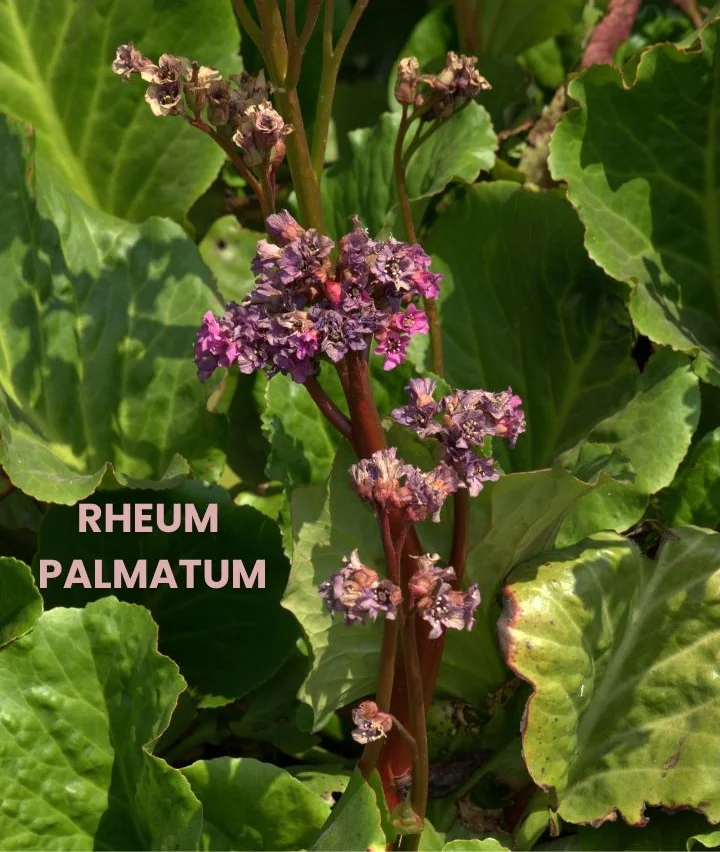Rheum palmatum, commonly known as rhubarb, is a valuable remedy in homeopathy, particularly for children experiencing digestive issues, especially sour diarrhea, and difficulties during teething.
Its use is marked by its ability to address sour-smelling conditions and gastrointestinal disturbances.

Table of Contents
ToggleSOURCE INFORMATION
Scientific Classification
- Kingdom: Plantae
- Clade: Tracheophytes
- Clade: Angiosperms
- Order: Caryophyllales
- Family: Polygonaceae
- Genus: Rheum
- Species: R. palmatum
Origin
- Rheum palmatum is native to Asia, specifically China and Tibet.
- It is known for its large, lobed leaves and thick, fleshy roots which have been used medicinally for centuries.
Historical Facts
- Rhubarb has been utilized in traditional Chinese medicine for over 2,000 years.
- It was introduced to Europe in the 14th century, where it quickly became a staple in both culinary and medicinal practices.
- Historically, rhubarb was prized for its potent purgative properties and was often used to treat digestive complaints and as a laxative.
DRUG PATHOGENESIS
- Rheum palmatum acts primarily on the digestive system, particularly the intestines.
- It is known for its sour-smelling discharges and the ability to alleviate colic, diarrhea, and teething troubles in children.
- It also affects the mind, inducing impatience and restlessness.
KEY CHARACTERISTICS
- Sour-smelling discharges
- Sour diarrhea, especially in children
- Restlessness and irritability during teething
- Colicky pains in the abdomen
- Profuse sweating on the scalp
DETAILED ORGAN SYMPTOMS
MIND
- Impatient and vehement: The child becomes easily frustrated and cries frequently, desiring many things but finding satisfaction in none.
HEAD
- Sweat on hairy scalp: Persistent and profuse sweating on the head.
- Cool sweat on the face: Especially around the mouth and nose.
MOUTH
- Much saliva: Excessive salivation is common.
- Sensation of coolness in teeth: The teeth may feel unusually cool.
- Difficult teething: The child is restless and irritable, often associated with sour breath.
STOMACH
- Desire for various kinds of food: Craves different foods but quickly tires of them.
- Throbbing in pit: A sensation of throbbing in the pit of the stomach.
- Feels full: A constant feeling of fullness.
ABDOMEN
- Colicky pain about navel: Intense abdominal pain around the navel area.
- Colic when uncovering: Pain increases when the abdomen is exposed.
- Wind seems to rise up to chest: Sensation of gas moving upwards towards the chest.
RECTUM
- Before stool, unsuccessful urging to urinate: A feeling of needing to urinate without success.
- Stools smell sour: Bowel movements are sour-smelling and pasty.
- Shivering and tenesmus: A sensation of incomplete evacuation, often with shivering.
- Burning in anus: A burning sensation in the anal area.
- Sour diarrhea during dentition: Sour-smelling diarrhea during teething periods.
MODALITIES
- Worse: Uncovering, after eating, moving about.
RELATIONSHIP WITH OTHER DRUGS
- Compare with: Magnesia phosphorica (Mag phos), Hepar sulphuris calcareum (Hep), Podophyllum (Pod), Chamomilla (Cham), Ipecacuanha (Ipec).
- Antidotes: Camphor (Camph), Chamomilla (Cham).
- Complementary: Magnesia carbonica (Mag carb).
DOSE
- Potency: Third to sixth potency is commonly used.
Frequently Asked Questions (FAQs)
What conditions is Rheum palmatum most commonly used for?
- Rheum palmatum is primarily used to treat digestive issues such as sour diarrhea, colic, and teething troubles in children.
How should Rheum palmatum be administered?
- It is typically administered in third to sixth potency, as recommended by a homeopathic practitioner.
Are there any side effects associated with Rheum palmatum?
- When used in the recommended potencies, Rheum palmatum is generally safe. However, it is always advisable to consult a homeopathic practitioner before use.
Can Rheum palmatum be used in adults?
- Yes, while it is commonly used in children, Rheum palmatum can also be effective in adults for similar digestive complaints.
What should be avoided while taking Rheum palmatum?
- It is best to avoid uncovering the abdomen and to be mindful of diet, as certain foods may aggravate symptoms.
Glossary of Difficult Words
- Vehement: Showing strong, passionate, or intense emotion.
- Salivation: The production and release of saliva.
- Tenesmus: A continual or recurrent inclination to evacuate the bowels, caused by disorder of the rectum or other illness.
- Throbbing: A pulsating sensation often associated with pain.
- Colic: Severe, often fluctuating pain in the abdomen caused by intestinal gas or obstruction.
- Uncovering: Exposing to air or view, in this context, it refers to exposing the abdomen.
- Pasty: Having a soft, moist texture.
This detailed drug picture of Rheum palmatum provides comprehensive insight into its uses, effects, and administration, enhancing understanding for both practitioners and patients.
